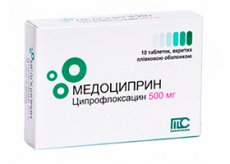Medical expert of the article
New publications
Preparations
Medication
Last reviewed: 23.04.2024

All iLive content is medically reviewed or fact checked to ensure as much factual accuracy as possible.
We have strict sourcing guidelines and only link to reputable media sites, academic research institutions and, whenever possible, medically peer reviewed studies. Note that the numbers in parentheses ([1], [2], etc.) are clickable links to these studies.
If you feel that any of our content is inaccurate, out-of-date, or otherwise questionable, please select it and press Ctrl + Enter.

Medociprin is an antibacterial agent.
Indications Medoccypine
It is used for diseases (affecting the respiratory tract, nasal sinuses, gallbladder, middle ear, eyes, digestive organs and bile ducts) that have inflammatory and infectious etiology (occurring with or without complications).
Used for therapy with adnexitis, gonorrhea, endometritis with prostatitis, and in addition with lesions of the bones, soft tissues with the epidermis and joints.
May be prescribed to people with immunodeficiency to prevent or treat infections (also during therapy with immunosuppressants and against the background of neutropenia).
Release form
The release of the component is in tablet form - a volume of 0.25 or 0.5 g, 10 pieces in each pack.
Pharmacodynamics
Medociprin is an artificial antimicrobial agent from the category of fluoroquinolone substances. It slows down the activity of the DNA gyrase enzyme, which is an important component of the process of chromosomal helixation and despiralization of the segments during the microbial reproduction stage.
The drug has a fast bactericidal effect on bacteria that reside both at the stage of rest and reproduction. Shows activity against virtually all gram (+) and gram (-) microbes (among them, and those that produce β-lactamase).
Citrobrobacter, serration, Salmonella with Proteus, Shigella, Providence and E. Coli with Klebsiella are highly sensitive to drugs. In addition to them, enterobacteria, Yersinia, Pasteurella, Hafnium, Morganella, Edwardsiella spp., Campylobacter with moracelly, Vibrio spp., And also staphylococcus with corynebacterium. Together with them in the list are Aeromonas spp., Legionella, listeria, hemophilus, neisserias with pseudomonads (among them pseudomonas fusillus) and brucella with Branchamella spp.
Moderate sensitivity is observed in streptococcus agalactia, gardnerellus vaginalis, pyogenic streptococci with fecal enterococci, chlamydia and pneumococci, and in addition in mycoplasmas, mycobacterium fortuitum with acinetobacteria, Flavobacterium spp. With Alcaligenes spp. And chop sticks.
Ureaplasma urealiticum, pale treponema, streptococcus complexion with bacteroids fragilis, as well as clostridium differential, and Nocardia asteroidés are usually resistant to medications.
Pharmacokinetics
Medociprin is well absorbed, reaching bioavailability values of approximately 70-80%. Plasma Cmax values are recorded after 1-1.5 hours.
Excretion proceeds to a greater degree through the kidneys (approximately 45% of the substance is in an unchanged state and approximately 11% more in the form of metabolic products). Another part is excreted by the intestine (approximately 20% of the drug is unchanged and approximately 5-6% in the form of metabolic products). The half-life is 3-5 hours.
Dosing and administration
Adults need to consume 0.25-0.75 g of the substance 2 times a day - for the treatment of infections affecting the respiratory system (a more accurate dosage is selected taking into account the severity of the pathology).
For pneumonia provoked by streptococci, 0.75 g of a substance is required 2 times a day. In the case of other infectious lesions, 0.5-0.75 g of drug is used daily. The therapeutic cycle lasts at least 5-10 days / maximum 1 month.
For gonorrhea, 0.25 g of Medociprin is used 1-fold.
People with kidney problems often do not need to change the dosage, excluding situations with significant renal impairment (CC values are less than 20 ml / minute). These patients need to halve the daily ration.
 [12]
[12]
Use Medoccypine during pregnancy
You can not assign women during lactation or pregnancy.
Side effects Medoccypine
The drug is often tolerated without complications, although nausea, itching, diarrhea, headache or muscle pain can sometimes occur, as well as pressure reduction, dizziness and pain in the abdominal area.
Occasionally, there is gustatory or olfactory disorder, jaundice, depression, ear noise, insomnia, and problems with kidney function. If the patient has such signs, you should immediately seek medical help.
Interactions with other drugs
The combination of the drug with theophylline causes an increase in the blood indicators of the latter.
When a drug is combined with iron, antacids (aluminum, magnesium, or calcium) or sucralfate, Medociprin absorption decreases. Because of this, it should be consumed 1-2 hours before or at least 4 hours after using these drugs.
Persons using the drug together with cyclosporine should monitor the level of blood creatine twice a week.
Combination with anticoagulants can prolong the period of blood coagulation.
Systemic use of fluoroquinolones with glibenclamide can cause a decrease in blood glucose levels.
 [13]
[13]
Storage conditions
Medociprin needs to be stored in a dark and dry place, closed from the penetration of young children. Temperature indicators - not higher than 25 ° C.

Shelf life
Medociprin can be used within a 3-year term since the release of the pharmaceutical substance.

Attention!
To simplify the perception of information, this instruction for use of the drug "Medication" translated and presented in a special form on the basis of the official instructions for medical use of the drug. Before use read the annotation that came directly to medicines.
Description provided for informational purposes and is not a guide to self-healing. The need for this drug, the purpose of the treatment regimen, methods and dose of the drug is determined solely by the attending physician. Self-medication is dangerous for your health.

